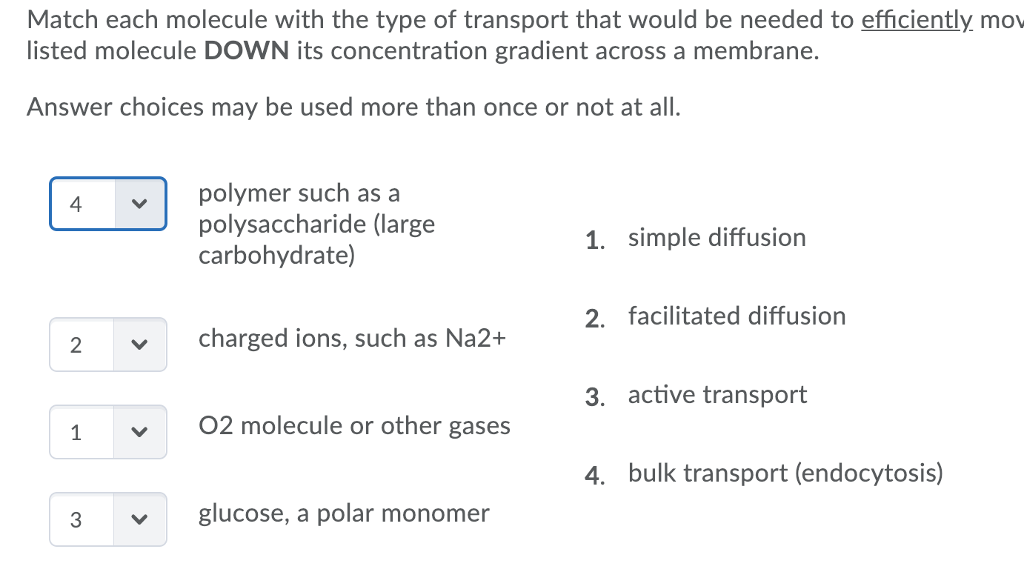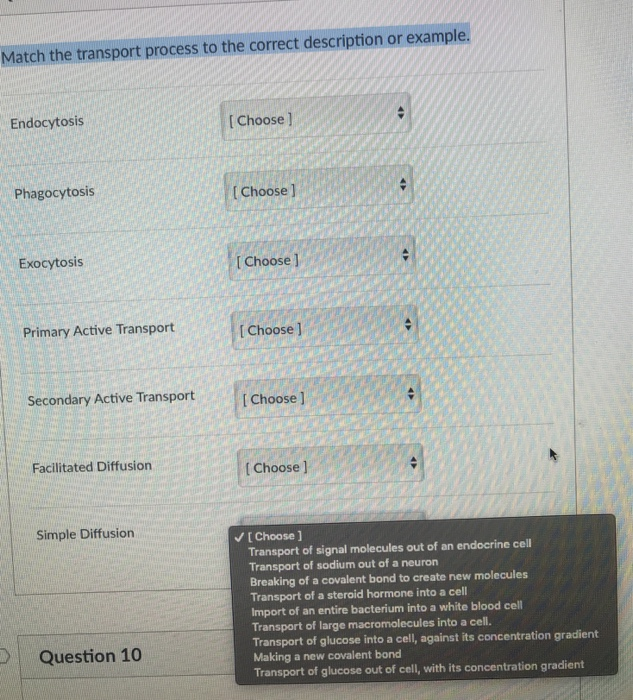Match the Modes of Transport to the Molecules
Since the cell membrane is. Thus it requires chemical energy to transport the components from lower to higher concentrated area or body part.
Convection is sometimes useful and can be purposefully invoked using a stirbar or a rotating electrode setup but for our purposes it is undesirable and solutions.

. Click again to see term. Active transport Movement of molecules from an area of high concentration to an area of. Ion Transport through Ionophores.
Passive transport is a naturally occurring phenomenon and does not require the cell to exert any of its energy to accomplish the movement. The following points highlight the five processes involved in transport of molecules across cell membrane. Cell membrane acts as a barrier to most but not all molecules.
Diffusion of large or polar hydrophilic molecules. In passive transport substances move from an area of higher concentration to an area of lower concentration. Diffusion Passive Transport 2.
Click card to see definition. Migration convection and diffusion. It is the biological process of movement of the molecules against the concentration gradient.
Polar molecules are soluble in water because the components of the molecule are more strongly attracted to water than to. Match the modes of transport to the molecules. Match the modes of transport to the molecules.
Modes of Transport of different molecules in blood WORKS CITED Polar Molecules Why are Polar Molecules soluble in Water. 4 Match the form of bulk transport with the correct description. Engulfing extracellular fluid and numerous dissolved molecules.
Select the correct option regarding it. It is the biological process of movements of the biochemical across the cell membranes and tissues. This cartoon illustrates passive diffusion.
Molecules will move from where the substance is more concentrated to where it is less concentrated. Convection is the movement of molecules in solution due to random thermal currents. Transport of specific large molecules into the cell.
Transport of a whole bacteria cell into an animal cell. Occurs through protein channels or carrier proteins channels move specific molecules across cell membrane. It is the process in which heat is transferred from one body to another body without involving the.
This is a spontaneous process and cellular energy is not expended. Tap card to see definition. In contrast potassium and sodium ions move across the nerve membrane against the concentration gradient through transport proteins by active process.
HIGH to LOW concentration. Movement of particles or molecules from an area of high concentration to an area of low concentration. Heating of milk in a pan.
The most direct forms of membrane transport are passive. Cell membranes are semi-permeable barrier separating the inner cellular environment from the outer cellular environment. Convection heat transfer occurs partly due to the actual movement of molecules or due to the mass transfer.
Secondary active transport created by primary active transport is the transport of a solute in the direction of its electrochemical gradient and does not directly require ATP. Process by which cells ingest extracellular fluid macromolecules and large particles including other cells. Molecules like glucose move by transport protein by the passive process.
The dashed line is intended to indicate a membrane that is. Primary active transport which is directly dependent on ATP moves ions across a membrane and creates a difference in charge across that membrane. You will use each option once Movement of large molecules out of the cell.
The cell membrane controls movement of materials into and out of the cell. Transport across cell membrane is classified into four ways. Each answer may include more than one item.
Passive transport is the diffusion of substances across a membrane. The following particles are moving from high concentration to low concentration and are using a carrier protein. Match the items to the correct answers in the key.
There are three possible ways that molecular transport occurs in an electrolyte solution. Look at the diagram of a cross-section of a cell membrane below. Select the correct option regarding it.
Tap again to see term. Type of passive transport. The given figure shows transport of two molecules A and B through three different modes of facilitated diffusion.

Solved Match The Type Of Transport With The Material That Is Chegg Com

Solved Match Each Molecule With The Type Of Transport That Chegg Com


No comments for "Match the Modes of Transport to the Molecules"
Post a Comment